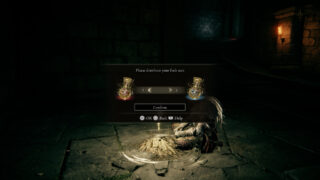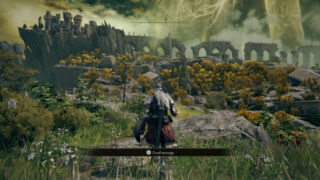Review: Elden Ring is From Software’s most vital game since Demon’s Souls
Those who worship at the church of Souls-like will find a game that’s basically everything they ever wanted
- Key Credits
- Hidetaka Miyazaki (Game director), Yui Tanimura (Co-director), Takeshi Suzuki (Programming director)

We could’ve spent months reviewing Elden Ring. Not because we needed that time to beat a particular boss, and not because it was so mentally taxing that we could only play it in short bursts, but because the game feels so incredibly massive and dense with mystery, that it feels like the public will only get a true sense of the magic of the game after it’s been out for a very long time.
Taking the Souls formula and applying it to an open world would be one thing, and frankly, if that’s all Elden Ring was, it would probably be warmly received by fans. However, for a game that has carried expectation in a way that few titles can approach, we’d hoped Elden Ring would try to be something more: to be the new gold standard for the genre and to be the largest paradigm shift for modern action-adventure games since Demon’s Souls landed over a decade ago.
And while it doesn’t quite reach those expectations, it’s still an absolutely incredible experience that fans will spend the next 6 months exploring.
When Demon’s Souls first released, the community that sprung up around that game was one that was desperate to discover every last secret. It was something entirely new, and while online communities for games like this had existed before, there was a momentum and scale to the early Souls community that contributed massively to the popularity of the series today.
If you imported a PS3 copy of Demon’s Souls from Japan, it was an adventure into the unknown. Elden Ring recaptures that sense of possibility in a way that no game in the series has since.
When you enter The Lands Between, you’ll be greeted with such a large landscape that it doesn’t feel like you’re playing a Souls game anymore. While the interconnected nature of the Souls maps has always been an element, it was common to see a castle in the distance and know that you’ll eventually get to fight something there, it’s nothing compared to how genuinely overwhelming it can feel to explore Elden Ring.
While the game will initially hold your hand and guide you in the right direction, after a few hours, players will have to make their own way. There are a few NPCs that’ll tell you generally where to go, but your best approach is to literally find some high ground, look at something that seems interesting (or more likely, menacing) and head in that direction.
The Souls games are perhaps known above anything else for their intense difficulty. While it can be argued that the games have always had ways to circumvent this, whether it was grinding for souls by repeating the same area over and over, or relying on certain weapons and playstyles that ease the challenge.
Elden Ring, while still often extremely difficult, offers an interesting balance that’s entirely new to the series. Since it’s an open-world game, and fairly quickly you can head in whichever direction you choose, there’s a non-linearity to how you encounter the world and its bosses. While there are some that you have to complete for story progression, there has never been so many sub and hidden bosses in a Souls game.
This presents a problem. With the very little guidance, the game gives you regarding where you should go next, we occasionally found ourselves smashing our heads against the wall of bosses we were clearly under-levelled for.
Similarly, by doing a lot of exploring, we also found ourselves reaching story critical moments that were supposed to pose a huge threat, only for them to be felled in a few shots thanks to the inadvertent grinding we happened to do on our travels.
“While there are some that you have to complete for story progression, there has never been so many sub and hidden bosses in a Souls game. This presents a problem, and one of Elden Ring’s greatest strengths.”
The natural cadence of the old games where every boss you encounter would be an evolved challenge from the previous one is somewhat lost, and you’ll also find yourself feeling as though you’re heading down the main path, only to realise you’ve just spent half a day on an optional boss, your only reward being a weapon that’s worse than the one you came in with.
The boss fights in these games can be nothing short of magical and Elden Ring absolutely delivers. We found ourselves loudly swearing just as much at the amazing set pieces and locations the fights take you to, as we did at the perfection most bosses demand. There is so much to this game, and the bosses, that hasn’t been seen yet. While the bosses are incredible to look at, and there’s literally nothing in games quite like taking one down, they aren’t without issue.
There are still plenty of times when a boss will kill you in one hit, with an attack that’s so un-telegraphed that it feels nothing but cheap. We’d really wished that by now, those types of encounters would have been ironed out, but it’s common enough to be a frustration. As mentioned previously, you can always leave these fights and venture into the wider world to level up before returning, but even then it feels like you’re beating the boss by force rather than by skill, which isn’t all that fun when compared to the boss fights in the game that feel tactical in an almost Sekiro-like way.
This isn’t an issue of ‘getting good’: it’s nothing but a disappointment when an extremely challenging fight, which is the best part of these games, turns on its head and there’s nothing you could have done about it. When a boss beats us, we want it to be because we’ve yet to master the mechanics, not because a beam from absolutely nowhere drained all our health without warning.

The story in Souls games has often been criticised for how obtuse it can be. With important pieces of lore hidden in item descriptions and in areas that no one would realistically look. On the other hand, plenty of players love this approach to storytelling, where everything you pick up could add some element of clarity to a massive, unknown world.
In what is one of the best decisions in Elden Ring, it’s significantly less secretive about telling you what’s actually going on. While that can occasionally feel like being waterboarded by exposition, it’s really crucial in a game of this size. We’re not in the era of Demon’s Souls levels being linear affairs with a few off-shoots. There are optional forts in Elden Ring that dwarf castle Boletaria.
Elden Ring essentially follows the player, the tarnished, who is tasked with uniting the pieces of the Elden Ring, in order to take a character to the Erdtree, the massive golden obelisk that stands above the entire world. Each ruin is held by a major boss, which is how the game handles progression.
“It’s significantly less secretive about telling you what’s actually going on. While that can occasionally feel like being waterboarded by exposition, it’s really crucial in a game of this size. We’re not in the era of Demon’s Souls levels being linear affairs with a few off-shoots.”
The narrative is certainly interesting, although it does sometimes trip up on itself whilst trying to explain the bigger concepts of the world. The smaller stories, like those involving NPCs that are hidden away in corners that few would look in, are often stronger because they feel self-contained and don’t require a glossary of terms to feel like you know what’s going on.
The game’s art style feels like a team wrestling with 6 adventures’ worth of inspiration and moulding it into one open world. It’s vast, colourful and breathtaking, but at the same time, it can be dark, disgusting and eerie. Veterans of the series will find themselves walking down streets and thinking, “this feels like Bloodborne” or scaling castle ramparts and being reminded of the first time they encountered the series, be that Demon’s or Dark Souls.
Enemies too are incredibly detailed. It’s a shame that you can only get a really good look at them once you’ve defeated them because there’s so much cool armour that we wish we could’ve gotten a look at. It’s likely that these armour sets exist somewhere in the game for the player to wear, but considering the sheer landmass of the map, it’ll be some time before there’s a complete list of all the fantastic outfits and where to find them.

This is arguably the 5 or 6th time that From is making a game on modern hardware that’s inspired by fairly similar high-fantasy origins, so it’s very impressive that while plenty of the areas are reminiscent of its old games, it never feels like a retread.
Boss fights also manage to feel fresh, while leaving room for a few sub-bosses that are very clear references to the hall of fame of Soul’s bosses. It’s a hugely celebratory game that feels like a gift to fans who’ve been with the series since its utterly impenetrable roots.
While the art direction and style of the game is unimpeachable, graphically, Elden Ring can often look dated. This isn’t helped by the visually incredible Demon’s Souls remake on PlayStation 5, but there are plenty of muddy textures throughout the world.
“Boss fights also manage to feel fresh, while leaving room for a few sub-bosses that are very clear references to the hall of fame of Soul’s bosses. It’s a hugely celebratory game that feels like a gift to fans who’ve been with the series since its utterly impenetrable roots.”
Faces and skin generally have always looked a bit strange in the Souls games, and Elden Ring is no exception. On PlayStation 5 we also encountered some performance issues, with stuttering occurring when the open-world was attempting to load in some grass textures and other bits of decoration.
This didn’t occur at all during indoor sections. The game offers two modes, one that prioritizes frame-rate and another that prioritises resolution. We stuck with the frame-rate options throughout, and while the game still looks good, especially with the overwhelming amount of colour that’s been used, it looks closer to something like Dark Souls 3 than the Demon’s Souls remake.
This doesn’t really matter in the bigger pictures, and if you’re concentrating on a boss fight, you’ll hardly notice it, but in the quiet moments, or taking a breather from the intense action, it’s something we picked up on.
Elden Ring is also a ridiculously long game. This will obviously vary if you happen to be the greatest Souls player to ever live, but there’s genuinely so much to do that a player could spend 50 hours in the opening few areas, only for the map to expand once again, full to the brim with new stuff to do.
We’ve played so much of this game, and we know there’s probably just as much we didn’t get to see. That’s incredibly exciting. That’s not even counting the countless mini-dungeons that are scattered throughout the map, or the rematches with past bosses you’ll find on your way towards the end of the game.
Rarely after a review do we feel so inclined to continue exploring a game to its absolute fullest, but with Elden Ring, there’s no way to know what that fullest actually entails. There are things in the distance that we don’t know how to reach. There are probably hundreds of secrets that will take a community full of players to actually uncover. It’s a sense of adventure that’s so rare in games, and one that we can’t recommend highly enough.
Elden Ring is a fantastic game that can still deliver the unmatched thrill of defeating a tough boss after an hours-long battle. Those who worship at the church of Souls-like will find a game that’s basically everything they ever wanted. There are more bosses than ever, more areas to explore, and so much lore to find that the digital archaeologists of the Souls community will be kept busy for years.
While minor technical issues and some dated graphics occasionally crop up, the art direction and world of Elden Ring is an absolute spectacle. It’s a very hard game, but one that affords you the chance to turn around, go off an adventure and come back later. And while it isn’t the revolution that Demon’s Souls was, it’s the closest FromSoftware have some to recapturing that magic once again.
Elden Ring is a fantastic game that can still deliver the unmatched thrill of defeating a tough boss after an hours-long battle. Those who worship at the church of Souls-like will find a game that’s basically everything they ever wanted.
- Incredible world
- Thrilling combat
- Unimpeachable art direction
- Some of the series best ever boss fights
- Occasional technical issues
- The graphics are a slightly dated
























